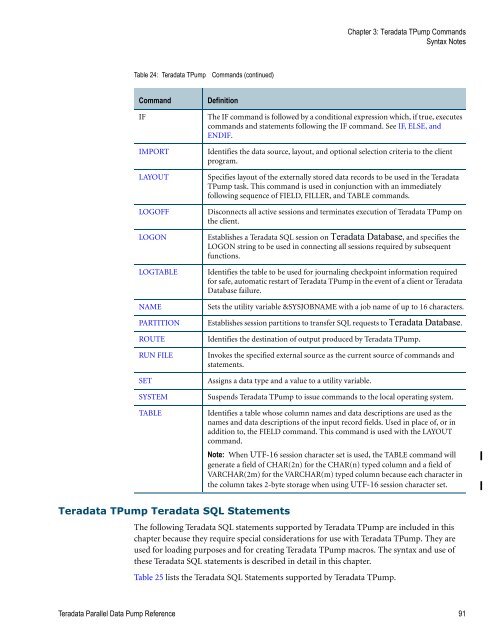Teradata Parallel Data Pump
Teradata Parallel Data Pump Reference - Teradata Developer ...
Teradata Parallel Data Pump Reference - Teradata Developer ...
- No tags were found...
Create successful ePaper yourself
Turn your PDF publications into a flip-book with our unique Google optimized e-Paper software.
Chapter 3: <strong>Teradata</strong> T<strong>Pump</strong> Commands<br />
Syntax Notes<br />
Table 24: <strong>Teradata</strong> T<strong>Pump</strong> Commands (continued)<br />
Command<br />
IF<br />
IMPORT<br />
LAYOUT<br />
LOGOFF<br />
LOGON<br />
LOGTABLE<br />
NAME<br />
PARTITION<br />
ROUTE<br />
RUN FILE<br />
SET<br />
SYSTEM<br />
TABLE<br />
Definition<br />
The IF command is followed by a conditional expression which, if true, executes<br />
commands and statements following the IF command. See IF, ELSE, and<br />
ENDIF.<br />
Identifies the data source, layout, and optional selection criteria to the client<br />
program.<br />
Specifies layout of the externally stored data records to be used in the <strong>Teradata</strong><br />
T<strong>Pump</strong> task. This command is used in conjunction with an immediately<br />
following sequence of FIELD, FILLER, and TABLE commands.<br />
Disconnects all active sessions and terminates execution of <strong>Teradata</strong> T<strong>Pump</strong> on<br />
the client.<br />
Establishes a <strong>Teradata</strong> SQL session on <strong>Teradata</strong> <strong>Data</strong>base, and specifies the<br />
LOGON string to be used in connecting all sessions required by subsequent<br />
functions.<br />
Identifies the table to be used for journaling checkpoint information required<br />
for safe, automatic restart of <strong>Teradata</strong> T<strong>Pump</strong> in the event of a client or <strong>Teradata</strong><br />
<strong>Data</strong>base failure.<br />
Sets the utility variable &SYSJOBNAME with a job name of up to 16 characters.<br />
Establishes session partitions to transfer SQL requests to <strong>Teradata</strong> <strong>Data</strong>base.<br />
Identifies the destination of output produced by <strong>Teradata</strong> T<strong>Pump</strong>.<br />
Invokes the specified external source as the current source of commands and<br />
statements.<br />
Assigns a data type and a value to a utility variable.<br />
Suspends <strong>Teradata</strong> T<strong>Pump</strong> to issue commands to the local operating system.<br />
Identifies a table whose column names and data descriptions are used as the<br />
names and data descriptions of the input record fields. Used in place of, or in<br />
addition to, the FIELD command. This command is used with the LAYOUT<br />
command.<br />
Note: When UTF-16 session character set is used, the TABLE command will<br />
generate a field of CHAR(2n) for the CHAR(n) typed column and a field of<br />
VARCHAR(2m) for the VARCHAR(m) typed column because each character in<br />
the column takes 2-byte storage when using UTF-16 session character set.<br />
<strong>Teradata</strong> T<strong>Pump</strong> <strong>Teradata</strong> SQL Statements<br />
The following <strong>Teradata</strong> SQL statements supported by <strong>Teradata</strong> T<strong>Pump</strong> are included in this<br />
chapter because they require special considerations for use with <strong>Teradata</strong> T<strong>Pump</strong>. They are<br />
used for loading purposes and for creating <strong>Teradata</strong> T<strong>Pump</strong> macros. The syntax and use of<br />
these <strong>Teradata</strong> SQL statements is described in detail in this chapter.<br />
Table 25 lists the <strong>Teradata</strong> SQL Statements supported by <strong>Teradata</strong> T<strong>Pump</strong>.<br />
<strong>Teradata</strong> <strong>Parallel</strong> <strong>Data</strong> <strong>Pump</strong> Reference 91









